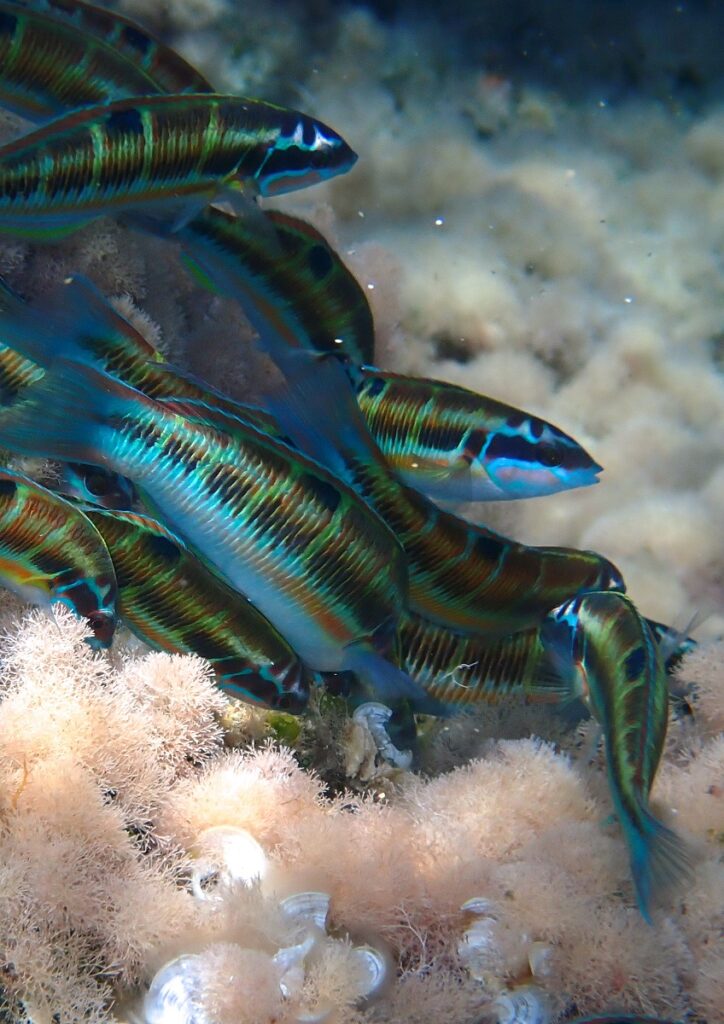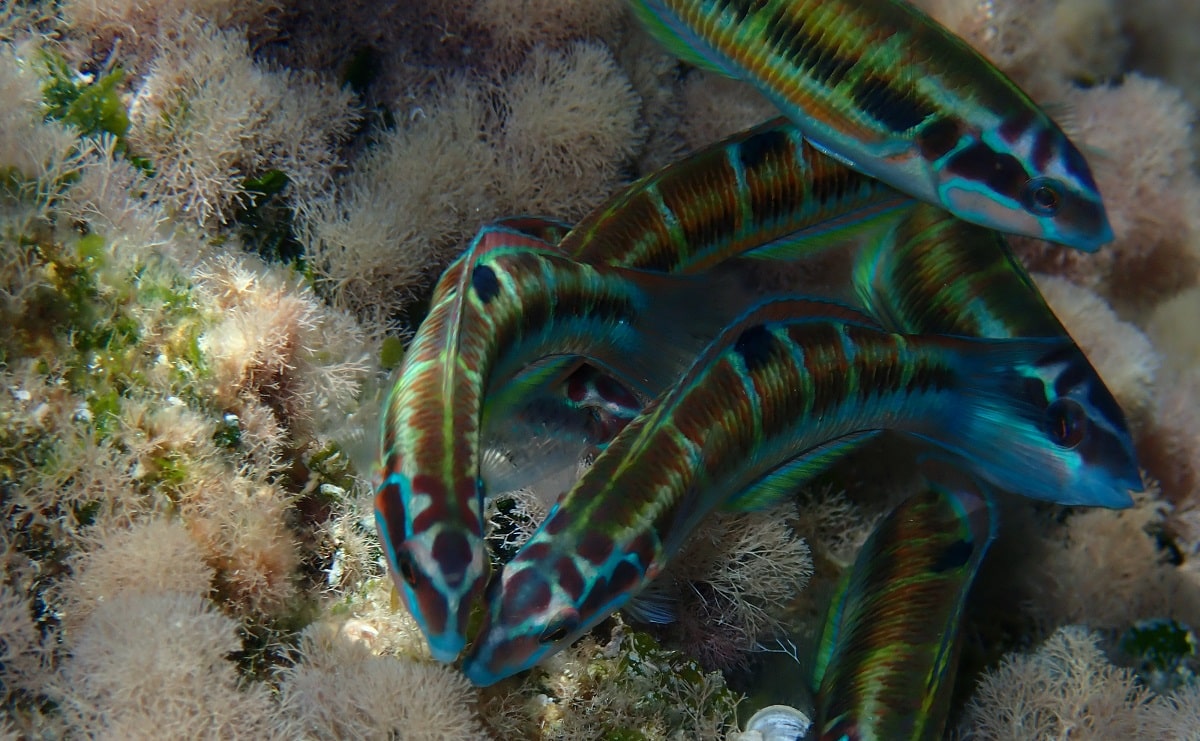Went snorkeling in the Mediterranean, or the eastern part of the Atlantic Ocean, and saw a dazzlingly colorful fish? You likely stumbled upon Thalassoma pavo, also (quite appropriately) known as the ornate wrasse. A true gem and always a delight to come across!
Below, find out everything there is to know about this rainbow-colored wrasse, including appearance, habitat, diet and reproduction.
| Name (common, scientific) | Ornate wrasse, Thalassoma pavo |
| Family | Labridae |
| Spread | Mediterranean and eastern Atlantic |
| Habitat | Mostly shallows, seagrass beds |
Ornate wrasse appearance
Scientifically known as Thalassoma pavo, the ornate wrasse is one of the most colorful fish you’ll encounter while snorkeling in the Mediterranean or eastern Atlantic. “Pavo” is Latin for “peacock”; pretty appropriate, if you ask me!
Ornate wrasses sport the typical slender body, nimble swimming pattern, oval head and pointy mouth of the wrasse family Labridae. They grow to a maximum length of around 10″.
It’s easy to distinguish between the males and females: the girls sport a pattern of vertical blue-green bars across their bodies and also show more orange coloration, which their male counterparts lack.
Like many other marine fish, ornate wrasses can change their sex. Specifically, females have the ability to change their colors and turn into males.

Ornate wrasse natural habitat
Range
This fish has a pretty wide natural range. It can be found in the warmer parts of the eastern Atlantic, from Portugal all the way down to the African country of Gabon, right at the equator. The species is a common sight around Macaronesia, particularly the Canary Islands, Madeira and the Azores.
The ornate wrasse is also pretty ubiquitous in the Mediterranean Sea, where it pops up in all but the most northern parts. This might soon change as a result of climate change, though: research indicates that these fish are already being spotted in the Ligurian Sea (above Corsica), which used to be too chilly for them.
The IUCN considers Thalassoma pavo to be a species of Least Concern, noting it’s a common fish and that its range seems to be expanding. They’re prized by fishermen in some places and are sometimes kept in the aquarium, but neither of these factors appears to be a real threat.
Did you know? Research indicates that Thalassoma pavo likely survived as a species in the warmer Mediterranean during the Pleistocene ice ages. After that, it slowly started moving back into the Atlantic through the Strait of Gibraltar and then outward.
Habitat
In their natural habitat, ornate wrasses are found down to 60 meters (~200 ft), although they usually stay in shallower waters than that. They prefer rocky zones with plenty of algae growth and are also common in seagrass (Poseidonia) beds.
If you come across Thalassoma pavo while snorkeling, you’ll usually find the females in small groups, like in the photos in this article. The males tend to be more solitary in nature, except during the mating season.
At night, this species digs itself into the sand to rest.
Planning your next snorkel trip?

Ornate wrasse facts
Diet
The ornate wrasse is mostly carnivorous. Juvenile fish often start out as cleaner fish, getting their meals by ridding other fish of parasites. Later on, they switch to hunting all sorts of small invertebrates, like crustaceans and mollusks.
Their diet includes copepods, amphipods, small crabs and many other species of underwater critters.
Reproduction
Interestingly, according to research, there are two types of Thalassoma pavo males. There are large sex-changed male fish that were previously females, and smaller ones that were born male. The latter are considered “secondary” and may behave like females.
As mentioned, male ornate wrasses are usually solitary. This changes when mating time rolls around in spring: larger individuals begin to fiercely guard certain mating sites, displaying territorial behavior toward other males. In the meantime, they gather harems of females that flock to these sites to mate.
Does that mean the smaller males are left out? Nope! Interestingly, mating doesn’t just happen in the harems. The species has also been observed to participate in big group spawnings, at least in areas where the population is dense enough. In these mass spawning events, even seemingly inferior males manage to reproduce.
The eggs are pelagic, which means they float freely in the water column. After they hatch, the larvae remain part of the floating oceanic plankton for up to 50 days, after which they head to the seagrass beds and reefs for safety and to find food.
If you have any more questions about the ornate wrasse, or if you’d like to share where you spotted this colorful fish, don’t hesitate to leave a comment below!
Sources & further reading


Thank you for an interesting, well written and a very informative contribution, Marijke. Did you get all the information from your listed references? Are you perhaps a trained scientist, or just an interested naturalist?
Hey, thanks! I’m glad you liked it. I’m just an enthusiast and a professional pop science writer who loves squeezing every last drop from available sources 🙂 Yeah, the references listed are the source of the majority of info, along with my own observations. Sources like IUCN are fantastic for pieces like this. Cheers!